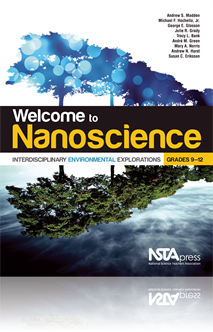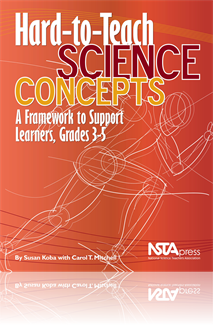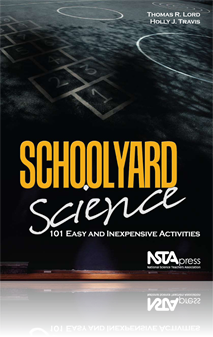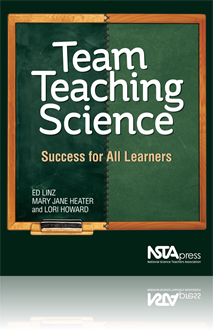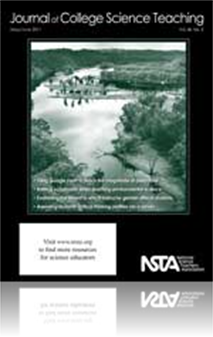All Resources
eBook
Welcome to Nanoscience: Interdisciplinary Environmental Explorations, Grades 9–12 (e-book)
In a society where technology plays an ever-increasing role, students’ ability to understand the underlying science and make smart social and environmental decisions based on that knowledge is crucial. Welcome to Nanoscience helps biology, chemistr...
eBook
Hard-to-Teach Science Concepts: A Framework to Support Learners, Grades 3–5 (e-book)
Authors Susan Koba and Carol Mitchell introduce teachers of grades 3–5 to their conceptual framework for successful instruction of hard-to-teach science concepts. Their methodology comprises four steps: (1) engage students about their preconception...
eBook
Project Earth Science: Astronomy, Revised 2nd Edition (e-book)
How well can your students … • Illustrate the reason for Earth’s seasons? • Explain how far a light year is? • Simulate the phases of the Moon? • Describe the effects of greenhouse gases? • Connect astronomy to other Earth sys...
eBook
Project Earth Science: Geology, Revised 2nd Edition (e-book)
How well can your students … • Explain the distribution of earthquakes? • Model volcanic eruptions? • Demonstrate plate motions and interactions? • Describe seafloor changes? • Think in terms of geologic time? ...
eBook
Schoolyard Science: 101 Easy and Inexpensive Activities (e-book)
With 101 easy and inexpensive activities to do on school grounds, Schoolyard Science can help students develop their observation and inquiry skills as well as an appreciation of their outdoor environment. Covering topics such as lower plants, gardens...
eBook
Team Teaching Science: Success for All Learners (e-book)
In Team Teaching Science, Ed Linz, Mary Jane Heater, and Lori A. Howard demonstrate the truth in the old adage “Two heads are better than one.” This guide for developing successful team-teaching partnerships that maximize student learning will h...
NSTA Press Book
Companion Classroom Activities for Stop Faking It! Force and Motion
Never has it been so easy for educators to learn to teach physical science with confidence. Award-winning author Bill Robertson launched his bestselling Stop Faking It! series with Force and Motion—offering elementary and middle school teachers a j...
By William C. Robertson, Ph.D.
Book Chapter
It is not difficult to think of reasons why it is important for students to understand that a round globe represents our planet. After all, Earth is our home in space. Environmentalists remind us that it’s the only home we have, so it’s importa...
Book Chapter
This chapter from, Companion Classroom Activities for Stop Faking It! Force and Motion is about motion. Activities include Time to Roll, Describing Motion, Different Speeds, and Evaluation. ...
Book Chapter
This chapter from, Companion Classroom Activities for Stop Faking It! Force and Motion is about Newton’s Third Law. Activities include Push Back, Newton’s Third Law, Exploding Canisters and Evaluation. ...
Book Chapter
This chapter from, Companion Classroom Activities for Stop Faking It! Force and Motion is about adding directions and vectors. Activities include Direction Matters and Vector Application....
Book Chapter
This chapter from, Companion Classroom Activities for Stop Faking It! Force and Motion is about Newton’s First Law. Activities include Objects at Rest and Staying at Rest. ...
Book Chapter
This chapter from, Companion Classroom Activities for Stop Faking It! Force and Motion is about Newton’s First Law. Activities include Objects in Motion, Galileo Explains It All, Sheep in a Jeep, With Coinage, and Evaluation. ...
Book Chapter
This chapter from, Companion Classroom Activities for Stop Faking It! Force and Motion is about forces. Activities include Changes in Motion and What Causes Them and Evaluation....
Book Chapter
This chapter from, Companion Classroom Activities for Stop Faking It! Force and Motion is about Newton’s Second Law. Activities include How Are These Things Related?, Newton’s Second Bit of Advice for All of Us, Second Law Balloons, and Evaluat...
Book Chapter
This chapter from, Companion Classroom Activities for Stop Faking It! Force and Motion is about gravity. Activities include Gravity on a Roll, Gravity—An Equal Opportunity Force, and Falling Pieces of Metal....
Book Chapter
This chapter from, Companion Classroom Activities for Stop Faking It! Force and Motion is about mass and weight. The activity in this chapter is Mass and Weight....
NSTA Press Book
Hard-to-Teach Science Concepts: A Framework to Support Learners, Grades 3–5
Authors Susan Koba and Carol Mitchell introduce teachers of grades 3–5 to their conceptual framework for successful instruction of hard-to-teach science concepts. Their methodology comprises four steps: (1) engage students about their preconception...
By Susan B. Koba with Carol T. Mitchell
eBook
Even More Brain-Powered Science: Teaching and Learning With Discrepant Events (e-book)
• How can water and a penny demonstrate the power of mathematics and molecular theory? • Do spelling and punctuation really matter to the human brain? ...
eBook
More Brain-Powered Science: Teaching and Learning With Discrepant Events (e-book)
• What can a chocolate chip cookie tell us about the Earth’s resources and the importance of environmental conservation? • How can a clear, colorless spray solution unveil a hidden message on a blank sign? ...
Book Chapter
This chapter from, Companion Classroom Activities for Stop Faking It! Force and Motion is about acceleration. Activities includes, Changing Motion, Accelerating, Acceleration or Not, and Evaluation. This free selection also includes the Table of Con...
Book Chapter
Introduction to Nanotechnology
Imagining differences in scale can be very easy (a softball is bigger than a baseball) or very difficult (how can we imagine the size of a galaxy?). It is perhaps most challenging to build conceptual frameworks for objects that are too small to see. ...
Book Chapter
Team Teaching Science at the High School Level
The focus of this chapter is the specific challenges of team teaching each individual discipline in the typical high school or secondary school. Although science curricula vary not only from state to state, but even district to district, there is gen...
Journal Article
Student Performances in Various Learning Protocols
A comparison was made between students' overall performance, as measured by overall grade, in different teaching and learning protocols. The data gathered indicate that students' conceptual learning is enhanced by the self-guided inquiry eBook and gr...
Journal Article
Favorite Demonstration: Learning the BCD-To-Seven-Segment Decoder By Counting Coins
This activity helps instructors to demonstrate a method of converting seven-bit binary numbers to decimal numbers and vice versa....
Journal Article
The GK–12 program offers graduate students unique teaching opportunities as students are paired with a teacher in a K–12 classroom. This article documents the benefits for teaching fellows in numerous areas, such as communication with various aud...
Journal Article
An Astronomical Misconceptions Survey
Misconceptions that students bring with them to the introductory science classroom are especially prevalent in astronomy. One way to identify and possibly dispel some of these misconceptions is through using a misconceptions survey. This article repo...
Journal Article
The Journal of College Teaching’s editor shares thoughts regarding the current issue....



